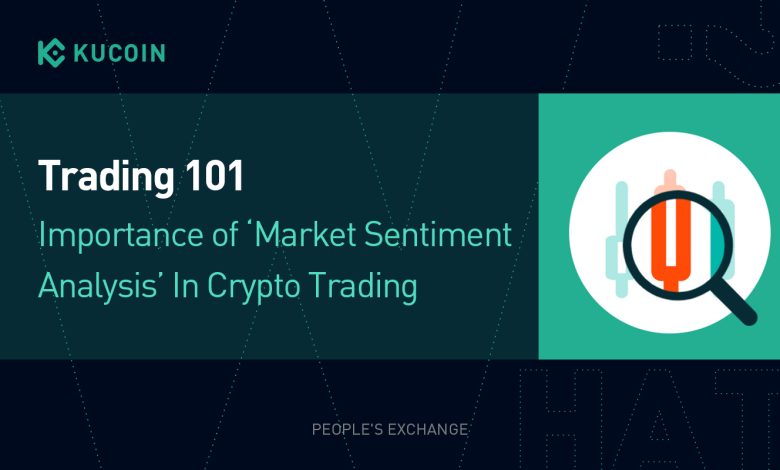The Role of Market Sentiment in Crypto Trading

- Understanding Market Sentiment in Crypto Trading
- The Impact of Emotions on Crypto Market Trends
- How Market Sentiment Influences Crypto Prices
- Strategies for Analyzing and Utilizing Market Sentiment in Trading
- The Psychology Behind Crypto Trading and Market Sentiment
- Measuring and Predicting Market Sentiment in the Crypto Industry
Understanding Market Sentiment in Crypto Trading
Understanding market sentiment in crypto trading is crucial for making informed investment decisions. Market sentiment refers to the overall feeling or attitude of traders and investors towards a particular cryptocurrency. It can be influenced by various factors such as news, social media, and market trends.
By analyzing market sentiment, traders can gain insights into whether the market is bullish or bearish, helping them anticipate price movements. Sentiment analysis tools and indicators can help traders gauge the mood of the market and make more strategic trading decisions.
It is essential to remember that market sentiment is not always rational and can be influenced by emotions such as fear and greed. Therefore, it is crucial to use sentiment analysis as one of many tools in your trading arsenal and not rely solely on it.
The Impact of Emotions on Crypto Market Trends
Emotions play a significant role in driving trends in the crypto market. Market sentiment is heavily influenced by emotions such as fear, greed, excitement, and panic. These emotions can lead to volatility in prices as traders react to news, rumors, and overall market conditions.
When traders are feeling optimistic about the future of a particular cryptocurrency, they may buy in large quantities, driving up the price. Conversely, when fear sets in, traders may sell off their holdings, causing prices to plummet. This cycle of emotions can create opportunities for savvy traders to capitalize on market fluctuations.
Understanding the impact of emotions on market trends is crucial for successful crypto trading. By monitoring sentiment indicators and staying informed about market news, traders can make more informed decisions about when to buy or sell. It’s essential to keep emotions in check and not let fear or greed dictate trading strategies.
How Market Sentiment Influences Crypto Prices
Market sentiment plays a crucial role in influencing the prices of cryptocurrencies. **Investors** and traders often make decisions based on their emotions and perceptions of the market rather than solely on fundamental or technical analysis. When **sentiment** is positive, it can drive prices up as more people are willing to buy, leading to an increase in demand. Conversely, when sentiment is negative, prices can drop as investors may sell off their holdings out of fear or uncertainty.
One of the key factors that contribute to market sentiment in the crypto space is **news** and social media. Positive news such as regulatory developments, partnerships, or adoption by mainstream institutions can create a bullish sentiment among investors. On the other hand, negative news like security breaches, regulatory crackdowns, or market manipulation can lead to a bearish sentiment, causing prices to decline.
Another factor that influences market sentiment is **market** trends and patterns. For example, if a particular cryptocurrency has been on a steady upward trend, investors may become more optimistic about its future prospects, leading to a positive sentiment. Conversely, if a cryptocurrency has been experiencing a series of price drops, investors may become more cautious or pessimistic, resulting in a negative sentiment.
It is essential for traders and investors to pay attention to market sentiment when making **trading** decisions. By understanding the emotions and perceptions of other market participants, one can better anticipate price movements and adjust their strategies accordingly. However, it is crucial to remember that market sentiment is **volatile** and can change rapidly, so it is essential to conduct thorough research and analysis before making any decisions based on sentiment alone.
Strategies for Analyzing and Utilizing Market Sentiment in Trading
When it comes to analyzing and utilizing market sentiment in trading, there are several strategies that traders can employ to make informed decisions. By understanding the emotions and attitudes of market participants, traders can gain valuable insights into potential price movements in the cryptocurrency market.
- Monitor social media platforms and forums to gauge the overall sentiment towards a particular cryptocurrency. By analyzing the conversations and opinions of other traders, you can get a sense of market sentiment and potential trends.
- Pay attention to news and events that could impact market sentiment. Positive news such as partnerships or regulatory approvals can lead to bullish sentiment, while negative news can result in bearish sentiment.
- Use technical analysis tools to identify patterns and trends that may indicate shifts in market sentiment. By combining technical analysis with sentiment analysis, traders can make more informed trading decisions.
- Consider sentiment indicators such as the Crypto Fear and Greed Index, which measures the emotions and sentiments of market participants. By tracking these indicators, traders can get a sense of whether the market is overbought or oversold.
- Utilize sentiment analysis tools and platforms that use natural language processing and machine learning algorithms to analyze social media and news sentiment. These tools can provide valuable insights into market sentiment and help traders make more informed decisions.
Overall, by incorporating market sentiment analysis into your trading strategy, you can gain a better understanding of market dynamics and potentially improve your trading performance in the cryptocurrency market. Remember to use a combination of fundamental analysis, technical analysis, and sentiment analysis to make well-rounded trading decisions.
The Psychology Behind Crypto Trading and Market Sentiment
The psychology behind crypto trading plays a significant role in determining market sentiment. Traders’ emotions and behaviors can heavily influence the price movements of cryptocurrencies. Understanding the psychological factors at play can help traders make more informed decisions and navigate the volatile crypto market more effectively.
One key psychological concept in crypto trading is **fear** and **greed**. When prices are falling, **fear** can drive traders to panic sell, leading to further price drops. On the other hand, when prices are rising, **greed** can cause traders to FOMO (fear of missing out) and buy at the peak, only to see the price plummet shortly after. Managing these emotions is crucial for successful trading.
Another important aspect of market sentiment is **sentiment analysis**. This involves analyzing social media, news articles, and other sources to gauge the overall **mood** of the market. Positive **sentiment** can lead to **bullish** behavior, while negative **sentiment** can result in **bearish** trends. Traders who can accurately interpret market **sentiment** may be able to anticipate price movements before they happen.
Moreover, **herd mentality** is a common phenomenon in crypto trading. When a large number of traders start buying or selling based on the actions of others, it can create **momentum** in the market. This **herd mentality** can sometimes lead to **irrational** exuberance or panic, causing prices to deviate from their intrinsic value.
In conclusion, understanding the psychology behind crypto trading and market sentiment is essential for navigating the volatile world of cryptocurrencies. By managing emotions, analyzing **sentiment**, and being aware of **herd mentality**, traders can make more informed decisions and potentially improve their trading outcomes.
Measuring and Predicting Market Sentiment in the Crypto Industry
Measuring and predicting market sentiment in the crypto industry is crucial for traders looking to make informed decisions. By analyzing social media trends, news articles, and other sources of information, traders can gain valuable insights into the overall mood of the market. This sentiment analysis can help traders anticipate price movements and adjust their strategies accordingly.
One popular method for measuring market sentiment is through the use of sentiment analysis tools. These tools use natural language processing algorithms to analyze text data and determine whether the sentiment is positive, negative, or neutral. By tracking sentiment over time, traders can identify trends and patterns that may indicate future price movements.
Another way to predict market sentiment is through the use of technical analysis. By studying historical price data and chart patterns, traders can identify key levels of support and resistance that may influence market sentiment. By combining technical analysis with sentiment analysis, traders can develop a more comprehensive understanding of market dynamics.



